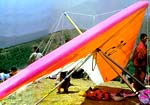


|
|
 |
| HOME | TRAVEL | TRAVELOG | ||

Fly with the Wind ... para-gliding over the Solang Valley "Go." The instructor's command rings out. And as one starts running downhill clutching the cords of the para-glider, the wind catches the polythene canopy trailing behind and it rises up. The next command is shouted across, ''Release.'' All cords barring the ones for steering and breaking are dropped. Then comes the all too brief but exhilarating experience of rising in the air, as light as a feather, gliding away as light as a feather, gently with the wind... till the canopy collapses slowly and the instructor commands, ''Stop.'' After the 'landing', the trainee must gather up the deflated canopy, neatly fold it and climb back uphill. with the six kg pack for a repeat performance. You are witness to a training session in progress for the adventure sport, para-gliding. This sport is becoming increasingly popular in India. Para-gliding emerged in the United States way back in 1961, but touched down in India only in 1991. And the rugged slopes of the enchanting Solang Valley in Himachal Pradesh provides an ideal location for novices as well as experienced fliers to practice the sport. The Solang Valley actually is a popular destination skiing and trekking too and its glacier nearby is breath-takingly beautiful minutes here. The para-glider has three main parts -- the canopy, the seat harness and the steering-cum-breaking cords. The canopy, made of a lightweight material, fills up with air and lifts the flyer off the ground. Once airborne, the flyer gets into the seat and straps himself with the harness. This also saves him from injuries while landing. The steering and breaking cords control the glider's speed and direction, and most important, it is essential for safe landing. ''A most crucial step in the initial stages for a learner is to understand the wind direction and speed and accordingly try to balance the canopy overhead,'' lectures Rajesh Sharma, chief instructor of the Hidimba Adventure Sports to a group of 14 students, whose course has been sponsored by the University Grants Commission, a central body for governing Indian universities. ''Move with the wind and pull the steering cord in the opposite direction to keep the canopy steady. In case the wind takes you to your left, go left but pull the right steering cord and vice versa. "But if the wind conditions are strong, it is better to relax on the ground rather than trying to go up as the canopy may fold up or the cords may get entangled or snap," he tells them. It takes about a day or two in the five-day basic course to master the art of keeping the canopy steadily overhead. ''The pain involved in climbing uphill with the six kg glider vanishes when one is successful in keeping the canopy overhead, '' says a participant after a perfect flight. Apart from practical lessons, the basic course has some theory classes on the development of the sport. ''Para-gliding emerged from US and gradually spread to Europe. But the tow method was in vogue those days. The next advance in the sport came two decades later when foot-launched gliders were introduced in the US,"' Sharma explains. The UGC began sponsoring students keen to learn para-gliding from 1992 and the sport has now become quite popular. Every year, between mid-October right up to early December nearly 90 to 100 students visit Solang Nallah, 14 km from Manali, to learn para-gliding. Apart from UGC, a number of private firms operating out of Manali organise para-gliding for tourists. It is on the third day of the course that the first attempts are made to take off into air. In the early stages, the instructor pushes the trainee from behind to help him gather the necessary momentum for the flight. ''Towards the end of the course, my role becomes more of an observer than a teacher,'' says Sharma. He does not have to do any prompting from the ground as the participants are able to manage the flight on their own. ''The sport would really take wings if the UGC provides more than the Rs 300 per candidate given to us now,'' he says. "After all the cost of the para glider is sky high.'' A glider with 90 hours life is imported from USA, Australia or any of the Nordic countries at a cost of Rs 60,000. For those who are unable or unwilling to undergo the rigours of learning this exciting sport, Solang valley offers 'tandem joyrides' ! Each ride cost Rs 400 for adults and Rs 250 for children and offers a bird's eye view from a height of more than 500 feet for 50 to 90 seconds for a distance of about 200 feet. But piggyback riding doesn't offer the same thrills as mastering the art yourself. "The experience was simply breathtaking when my feet slowly began to dangle in the air. I felt as light as cotton as the wind took my weight,'' says a participant after his maiden flight. UNI
|
|
| Fast Facts | |
|
|
|
|
HOME |
NEWS |
BUSINESS |
CRICKET |
MOVIES |
CHAT
INFOTECH | TRAVEL | LIFE/STYLE | FREEDOM | FEEDBACK |
|